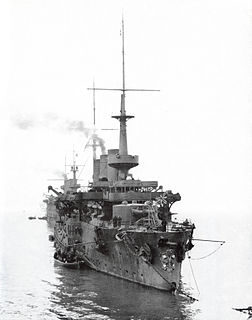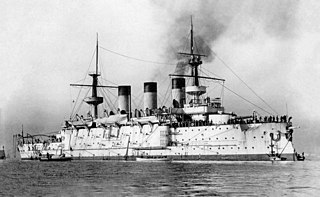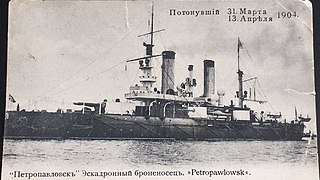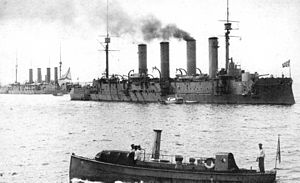
Mikasa (三笠) is a pre-dreadnought battleship built for the Imperial Japanese Navy (IJN) in the late 1890s. Named after Mount Mikasa in Nara, Japan, the ship served as the flagship of Vice Admiral Tōgō Heihachirō throughout the Russo-Japanese War of 1904–1905, including the Battle of Port Arthur on the second day of the war and the Battles of the Yellow Sea and Tsushima. Days after the end of the war, Mikasa's magazine accidentally exploded and sank the ship. She was salvaged and her repairs took over two years to complete. Afterwards, the ship served as a coast-defence ship during World War I and supported Japanese forces during the Siberian Intervention in the Russian Civil War.

The Borodino-class battleships were a group of five pre-dreadnought battleships built for the Imperial Russian Navy around the end of the 19th century. Their design was based on that of the French-built Tsesarevich modified to use Russian equipment. The first four ships were finished after the start of the Russo-Japanese War of 1904–1905 and were among the ships ordered to sail from the Baltic Sea to the Far East to relieve the Pacific Squadron besieged by the Japanese in Port Arthur. Three of these ships were sunk and one was captured by the Imperial Japanese Navy at the Battle of Tsushima in 1905. The fifth and final ship, Slava, was not completed in time to participate in the war and served with the Baltic Fleet through World War I.

Aki (安芸) was one of two Satsuma-class semi-dreadnought battleship built for the Imperial Japanese Navy (IJN) during the first decade of the 20th century. She was the second battleship built domestically in Japan and the first to use steam turbines for propulsion. The ship was named for Aki Province, now a part of Hiroshima Prefecture. The ship saw no combat during World War I. Aki was disarmed in 1922 and sunk as a target in 1924 in accordance with the terms of the Washington Naval Treaty of 1922.

Nisshin (日進), also transliterated as Nissin, was a Kasuga-class armored cruiser of the Imperial Japanese Navy, built in the first decade of the 20th century by Gio. Ansaldo & C., Sestri Ponente, Italy, where the type was known as the Giuseppe Garibaldi class. The ship was originally ordered by the Royal Italian Navy in 1901 as San Rocco and sold the next year to the Argentine Navy who renamed her Mariano Moreno during the Argentine–Chilean naval arms race, but the lessening of tensions with Chile and financial pressures caused the Argentinians to sell her before delivery. At that time tensions between the Empire of Japan and the Russian Empire were rising, and the ship was offered to both sides before she was purchased by the Japanese.

Rurik was the last armored cruiser to be built for the Imperial Russian Navy. The ship was designed by the British firm Vickers and built in their shipyard, being laid down in 1905 and completed in 1908. She was armed with a main battery of four 254 mm (10 in) guns and a secondary battery of eight 203 mm (8 in) guns; her top speed was rated at 21 knots. Despite her powerful gun armament, Rurik was rendered obsolescent even before she was completed by the advent of the British battlecruisers of the Invincible class, which were more powerfully armed and faster. Her design is nevertheless well regarded and naval historians rate her as one of the best vessels of her type ever built.

Pobeda was the last of the three Peresvet-class pre-dreadnought battleships built for the Imperial Russian Navy at the end of the nineteenth century. The ship was assigned to the Pacific Squadron upon completion and based at Port Arthur from 1903. During the Russo-Japanese War of 1904–1905, she participated in the battles of Port Arthur and the Yellow Sea. Having escaped serious damage in these engagements, Pobeda was sunk by gunfire during the siege of Port Arthur, and then salvaged by the Japanese and placed into service under the name Suwo (周防).

The Peresvet class was a group of three pre-dreadnought battleships built for the Imperial Russian Navy around the end of the 19th century. Peresvet and Pobeda were transferred to the Pacific Squadron upon completion and based at Port Arthur from 1901 and 1903, respectively. All three ships were lost by the Russians in the Russo-Japanese War of 1904–05; Peresvet and Pobeda participated in the Battles of Port Arthur and the Yellow Sea and were sunk during the siege of Port Arthur. Oslyabya, the third ship, sailed to the Far East with the Second Pacific Squadron to relieve the Russian forces blockaded in Port Arthur and was sunk at the Battle of Tsushima with the loss of over half her crew.

The Petropavlovsk class, sometimes referred to as the Poltava class, was a group of three pre-dreadnought battleships built for the Imperial Russian Navy during the 1890s. They were transferred to the Pacific Squadron shortly after their completion in 1899–1900 and were based at Port Arthur before the start of the Russo-Japanese War of 1904–1905. All three ships participated in the Battle of Port Arthur on the second day of the war. Petropavlovsk sank two months after the war began after striking one or more mines laid by the Japanese. Her two sister ships, Sevastopol and Poltava, took part in the Battle of the Yellow Sea in August 1904 and were sunk or scuttled during the final stages of the siege of Port Arthur in early 1905.

Navarin was a pre-dreadnought battleship built for the Imperial Russian Navy in the late 1880s and early 1890s. The ship was assigned to the Baltic Fleet and spent the early part of her career deployed in the Mediterranean and in the Far East. She participated in the suppression of the Boxer Rebellion in 1900 before returning to the Baltic Fleet in 1901. Several months after the beginning of the Russo-Japanese War in February 1904, she was assigned to the 2nd Pacific Squadron to relieve the Russian forces blockaded in Port Arthur. During the Battle of Tsushima in May 1905, she was sunk by Japanese destroyers which spread twenty-four linked mines across her path during the night. Navarin struck two of these mines and capsized with the loss of most of her crew.

The Russian battleship Poltava was one of three Petropavlovsk-class pre-dreadnought battleships built for the Imperial Russian Navy in the 1890s. The ship was transferred to the Pacific Squadron shortly after completion and based at Port Arthur from 1901. During the Russo-Japanese War of 1904–1905, she participated in the Battle of Port Arthur and was heavily damaged during the Battle of the Yellow Sea. She was sunk by Japanese artillery during the subsequent siege of Port Arthur in December 1904, but was raised by the Imperial Japanese Navy (IJN) after the war and renamed Tango (丹後).

Peresvet was the lead ship of the three Peresvet-class pre-dreadnought battleships built for the Imperial Russian Navy at the end of the nineteenth century. The ship was transferred to the Pacific Squadron upon completion and based at Port Arthur from 1903. During the Russo-Japanese War of 1904–1905, she participated in the Battle of Port Arthur and was seriously damaged during the Battle of the Yellow Sea and again in the siege of Port Arthur. The ship was scuttled before the Russians surrendered, then salvaged by the Japanese and placed into service with the name Sagami (相模).

The cruiser Bayan was the name ship of the four Bayan-class armoured cruisers built for the Imperial Russian Navy in the first decade of the 20th century. The ship had to be built in France because there was no available capacity in Russia. Bayan was assigned to the First Pacific Squadron after completion and based at Port Arthur from the end of 1903. She suffered minor damage during the Battle of Port Arthur at the beginning of the Russo-Japanese War of 1904–05 and supported destroyers as they patrolled outside the harbour. After bombarding Japanese positions in July 1904, the ship struck a mine and was out of action for the next several months. Bayan was sunk during the Siege of Port Arthur and was then salvaged by the Japanese after the war.

Petropavlovsk was the lead ship of her class of three pre-dreadnought battleships built for the Imperial Russian Navy during the last decade of the 19th century. The ship was sent to the Far East almost immediately after entering service in 1899, where she participated in the suppression of the Boxer Rebellion the next year and was the flagship of the First Pacific Squadron.

Oslyabya was the second of the three Peresvet-class second-class pre-dreadnought battleships built for the Imperial Russian Navy at the end of the nineteenth century, although construction delays meant that she was the last to be completed. The ship was part of the Second Pacific Squadron sent to the Far East during the Russo-Japanese War of 1904–05, and served as the flagship of Rear Admiral Baron Dmitry von Fölkersam. Oslyabya was sunk on 27 May 1905 at the Battle of Tsushima, and was the first all-steel battleship to be sunk by naval gunfire alone. Sources differ on the exact number of casualties, but over half her crew went down with the ship.

Pallada was the last of the four Bayan-class armored cruisers built for the Imperial Russian Navy in the first decade of the 20th century. She was assigned to the Baltic Fleet during World War I where she captured codebooks from the German cruiser Magdeburg that had run aground during the first month of the war. The ship was torpedoed by a German submarine in October 1914 and exploded; none of the crew survived. Pallada was the first warship lost by the Russians during the war.

The Tsukuba-class cruisers were a pair of large armored cruisers built for the Imperial Japanese Navy (IJN) in the first decade of the 20th century. Construction began during the Russo-Japanese War of 1904–05 and their design was influenced by the IJN's experiences during the war. The British development of the battlecruiser the year after Tsukuba was completed made her and her sister ship Ikoma obsolete, as they were slower and more weakly armed than the British, and later German, ships. Despite this, they were reclassified in 1912 as battlecruisers by the IJN.

The Pallada-class cruisers were a group of three protected cruisers built for the Imperial Russian Navy (IRN) in the late 1890s. One ship of the class, Aurora, is still crewed by the Russian Navy, and maintained as a museum ship.

Bayan was the third of the four Bayan-class armoured cruisers built for the Imperial Russian Navy in the early 1900s. The ship was assigned to the Baltic Fleet. She was modified to lay mines shortly after World War I began. Bayan laid mines herself and provided cover for other ships laying minefields. The ship fought several inconclusive battles with German ships during the war, including the Battle of Åland Islands in mid-1915. She also participated in the Battle of Moon Sound during the German invasion of the Estonian islands in late 1917, where she was damaged. Bayan was decommissioned in 1918 and sold for scrap in 1922.

Admiral Makarov was the second of the four Bayan-class armoured cruisers built for the Imperial Russian Navy during the mid-1900s. While initially assigned to the Baltic Fleet, the ship was detached to the Mediterranean several times before the start of World War I in 1914. She was modified to lay mines shortly after the war began. Admiral Makarov laid mines herself during the war and provided cover for other ships laying minefields. The ship fought several inconclusive battles with German ships during the war, including the Battle of Åland Islands in mid–1915. She also defended Moon Sound during the German invasion of the Estonian islands in late 1917. Admiral Makarov was decommissioned in 1918 and sold for scrap in 1922.
The 15 cm/45 41st Year Type was a British naval gun designed by the Elswick Ordnance Company for export in the years before World War I that armed warships of the Imperial Japanese Navy. These guns served aboard Japanese ships during World War I and as coastal artillery during World War II.























